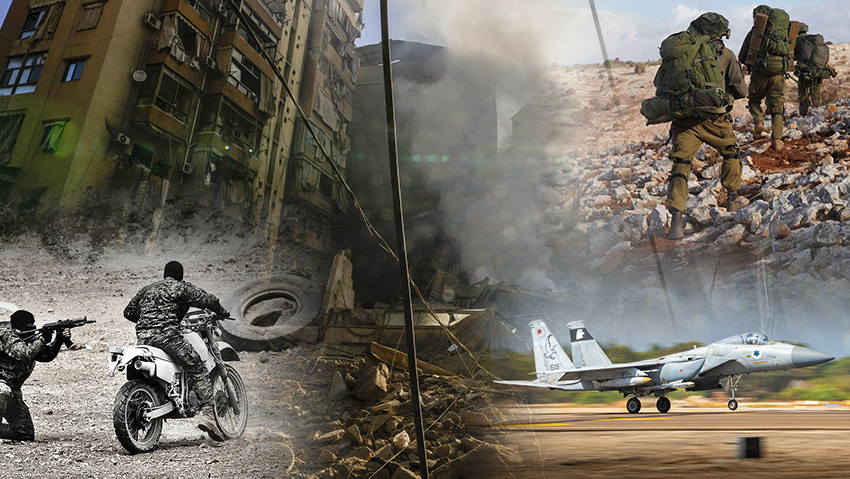Since the IDF maneuver began in southern Lebanon, Hezbollah has issued around 100 claims of responsibility for actions against Israel and its forces, including within Lebanon; In this period, IDF operations have resulted in the elimination of more than 250 terrorists, including 21 commanders, over four days of focused activity
Lior Ben Ari|
Since the IDF began its maneuver in southern Lebanon last Monday, Hezbollah has issued approximately 100 "claims of responsibility" for actions against Israel and IDF specifically, including within Lebanon. In some statements, the Shiite terrorist organization claimed it fired at gathering areas on the northern border where IDF troops were preparing for a ground entry into Lebanon for the first time since 2006.
In recent days, there has been a significant increase in Hezbollah's claims of responsibility, with some turning out to be false or at least inaccurate. The terrorist organization's apparent aim is to project "achievements" on the ground, likely due to distress following a series of senior eliminations in Lebanon.
Alongside attacks against IDF soldiers maneuvering in southern Lebanon, Hezbollah continued its relentless firing toward Israeli territory, which also expanded to additional areas. After launching a rocket aimed at Tel Aviv for the first time last week, Hezbollah this week launched its first major barrage toward the country's center, triggering alarms in Tel Aviv and surrounding region. According to the terrorist organization, this was firing at "Base 8200 in Glilot and Mossad headquarters" and at "the airbase in Sde Dov."
Firing toward Haifa, surrounding towns, the Lower Galilee, and the bases in these areas, which was considered unusual until a few weeks ago, has become much more frequent over the past week and the one before. For comparison, until the beginning of Operation "Northern Arrows" in the middle of last month, alarms were heard in Haifa only twice since the start of the war. In contrast, over the past two weeks, no fewer than 14 alerts have been activated throughout the city.

(Photo: AP/Hassan Ammar, דובר צה"ל, AFP)
Since the maneuver began this week, according to IDF data, more than 700 launches from Lebanon to Israel have been identified. Since the IDF entered Lebanon on the ground, Hezbollah has claimed in several statements that it managed to cause casualties among the fighting forces on the ground and described "clashes with IDF forces" in other statements. However, many of these announcements have been found to be inaccurate.
250 terrorists eliminated, over 2,000 targets attacked
Alongside the difficult incidents and the heavy toll, IDF is recording achievements in the fighting in southern Lebanon. During four days of focused activity in southern Lebanon, more than 250 terrorists have been eliminated, according to the IDF, including 21 commanders. IDF spokesperson updated that among the eliminated commanders, there are five at the battalion commander level, ten company commanders, and six platoon commanders. Additionally, the army estimates that the entire southern Lebanon region has been evacuated of population, with a total of about 600,000 having left and reached north of the Litani River.
Forces operate in southern Lebanon in brigade formation attacks, combining aerial activity alongside tanks and artillery. The IDF added that during the activity, forces are eliminating terrorists entrenched in buildings and locations close to the fence, locating and destroying weapons storage, ready-to-launch launchers, and Hezbollah's charges left behind.
The forces' activity has so far been carried out from controlling areas over six villages, focusing on Hezbollah operatives and weapon stockpiles, even underground. "We are combing with iron combs and finding much more than we knew. We located dozens of large weapons caches. We found many more underground infrastructures than we knew, including supply tunnels of 40-50 meters—and we have begun destroying those infrastructures. The Paratroopers Brigade eliminated 15 terrorists who emerged from shafts and hideouts in the last 24 hours," IDF relayed.
"The most intense aerial combat in the world in the past 20 years"
Additionally, Air Force operates above and around ground forces—at all hours of the day. From preemptive strikes against military targets in the raid destinations to removing threats in the area through collection and attack missions. So far, more than 2,000 military targets have been attacked, including terror infrastructures, military buildings, weapons storage, and launchers. According to reports in Lebanon and IDF announcements, the main target areas of the Air Force are southern Lebanon, the Al-Bekaa area in the east, connecting Lebanon with Syria, and the Dahiya of Beirut.

IDF strikes southern Lebanon
(Photo: REUTERS/Aziz Taher)

IDF strikes southern Lebanon
(Photo: REUTERS/Aziz Taher)
Data published last night on CNN showed that Israel is bombing across Lebanon more than the US at the peak of its fight against ISIS and at a higher rate than the US military attacked in its war in Afghanistan. According to data from the Lebanese Ministry of Health, more than 1,400 people have been killed in the country in the past three weeks due to the massive airstrikes. Additionally, more than 7,500 others were injured. However, data from the Ministry of Health in Lebanon are not always accurate, as not all casualties reach treatment in various hospitals.
It should be noted that Israel, for its part, sends messages to civilians in Lebanon before attacking certain areas. Just last week, several such warnings were sent to residents of the Dahiya district and its surroundings, where Israel attacked significant weapon stockpiles. In that district, as known, a number of senior Hezbollah officials, including the organization's Secretary-General Hassan Nasrallah, were eliminated in an airstrike about a week ago.
According to Airwars, which monitors and collects data on airstrikes in conflict zones, "Israel's bombings, which it says are aimed at Hezbollah strongholds, mark the most intensive aerial campaign in the world outside Gaza in the past two decades."
No comments:
Post a Comment